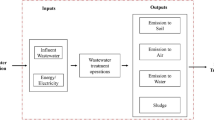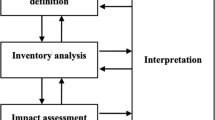Abstract
With rapid urbanization sweeping through emerging nations, such as India, there has been a substantial increase in wastewater production, which poses a significant challenge in terms of its treatment and sustainable use. Conventional wastewater treatment methods, including the moving bed biofilm reactor (MBBR), up-flow anaerobic sludge blanket (UASB), membrane bioreactor (MBR), activated sludge process (ASP), sequencing batch reactors (SBR), and others, have demonstrated their effectiveness but come at a considerable cost. As these systems age, their operational and maintenance expenses escalate, rendering them less practical and sustainable. Despite the establishment of numerous wastewater treatment plants aimed at adhering to the regulations set forth by the Central Pollution Control Board of India (CPCB), high operating and maintenance costs have resulted in the abandonment of many of these facilities. There is a persistent need for sustainable, cost-effective, and environmentally friendly wastewater management technology to address this pressing issue. A solid immobilised biofilter (SIBF) system is currently under research as a potential solution because of its natural, cost-efficient, and sustainable characteristics. This study engages in a compelling comparative case study of two hospitals in Maharashtra, India. This contrasts the conventional wastewater treatment method (MBBR) with the natural treatment approach (SIBF). This study utilizes a 30-year life cycle cost analysis approach, which distinctly reveals that the MBBR system carries a higher life cycle cost. In contrast, the SIBF system has significantly lower costs because of its reduced energy consumption and operational costs. Four laboratory tests, namely biological oxygen demand, chemical oxygen demand, total suspended solids, and pH, were used to evaluate the quality of the treated wastewater. This research makes a significant contribution to the field of cost-effective wastewater management solutions by evaluating the feasibility of system implementation.

(Source: CPCB Report, March 2021)

(Source: CPCB Report, March 2021)






Similar content being viewed by others

Data availability
The data that support the findings of this study are available from the corresponding author.
References
Castellar, J. A. C., Torrens, A., Buttiglieri, G., Monclús, H., Arias, C. A., Carvalho, P. N., Galvao, A., & Comas, J. (2022). Nature-based solutions coupled with advanced technologies: An opportunity for decentralized water reuse in cities. Journal of Cleaner Production, 340, 130660. https://doi.org/10.1016/j.jclepro.2022.130660
Corbella, C., Puigagut, J., & Garfí, M. (2017). Life cycle assessment of constructed wetland systems for wastewater treatment coupled with microbial fuel cells. Science of The Total Environment, 584–585, 355–362. https://doi.org/10.1016/j.scitotenv.2016.12.186
CPCB India Report, March 2021.
Gallego-Schmid, A., & Tarpani, R. R. Z. (2019). Life cycle assessment of wastewater treatment in developing countries: A review. Water Research. https://doi.org/10.1016/j.watres.2019.01.010
Ilyas, M., Kassa, F. M., & Darun, M. R. (2021). Life cycle cost analysis of wastewater treatment: A systematic review of literature. Journal of Cleaner Production, 310, 127549. https://doi.org/10.1016/j.jclepro.2021.127549
Joshi, Rajkumar, Ahmed, Sirajuddin, & |,. (2016). Status and challenges of municipal solid waste management in India: A review. Cogent Environmental Science, 2(1), 1139434. https://doi.org/10.1080/23311843.2016.1139434
Kalbar, P. P. (2021a). Hybrid treatment systems: A paradigm shift to achieve sustainable wastewater treatment and recycling in India. Clean Techn Environ Policy, 23, 1365–1373. https://doi.org/10.1007/s10098-021-02034-
Kalbar, P. P. (2021b). Need for adapting hybrid treatment systems to reduce O & M cost of sewage treatment and recycling in India. Journal of Indian water works. https://www.researchgate.net/publication/357578990_Need_for_Adopting_Hybrid_Treatment_Systems_to_Reduce_OM_Costs_of_Sewage_Treatment_and_Recycling_in_India
Kaur, R., Wani, S. P., Singh, A. K. & Lal, K. (2012, May). Wastewater production, treatment and use in India. In National Report presented at the 2nd regional workshop on Safe Use of Wastewater in Agriculture (pp. 1–13).
Kumar, A., & Agrawal, A. (2020). Recent trends in solid waste management status, challenges, and potential for the future Indian cities – A review. Current Research in Environmental Sustainability. https://doi.org/10.1016/j.crsust.2020.100011
Kumari, A., Maurya, N. S., & Tiwari, B. (2020). Hospital wastewater treatment scenario around the globe. Current Developments in Biotechnology and Bioengineering. https://doi.org/10.1016/B978-0-12-819722-6.00015-8
Kumar, M., Kuroda, K., Joshi, M., Bhattacharya, P., & Barcelo, D. (2021). First comparison of conventional activated sludge versus root-zone treatment for SARS-CoV-2 RNA removal from wastewaters: Statistical and temporal significance. https://doi.org/10.1016/j.cej.2021.130635
Kumar, S., Smith, S. R., Fowler, G., Velis, C., Kumar, S. J., Arya, S., ... & Cheeseman, C. (2023). Challenges and opportunities associated with waste management in India. https://doi.org/10.1098/rsos.160764
Lin, J., Li, J., Xu, Y., Xie, M., Zhao, S., and Ye, W. (2023). Editorial: Wastewater treatment & resource recovery technologies: Frontiers in Bioengineering and Biotechnology. 11, https://doi.org/10.3389/fbioe.2023.1150044
Lopsik, K. (2013). Life cycle assessment of small-scale constructed wetland and extended aeration activated sludge wastewater treatment system. International Journal of Environmental Science and Technology, 2013(10), 1295–1308.
Madan, S., Madan, R., and Hussain, A. (2022). Advancement in biological wastewater treatment using hybrid moving bed biofilm reactor (MBBR): a review: Applied Water Science. 12 6 141 https://doi.org/10.1007/s13201-022-01662-y
Muhammad Ilyas, Freselam Mulubrhan Kassa, Mohd Ridzuan Darun. (2021). Life cycle cost analysis of wastewater treatment: A systematic review of literature. Journal of cleaner production.https://doi.org/10.1016/j.jclepro.2021.127549
NITI Ayog Report, August 2022.
Obaideen, K., Shehata, N., Sayed, E.T., Abdelkareem, M.A., Mahmoud, M.S., and Olabi, A.G. (2022). The role of wastewater treatment in achieving sustainable development goals (SDGs) and sustainability guideline. Energy Nexus, 7, 100112, https://doi.org/10.1016/j.nexus.2022.100112
Omondi, D. O, & Caren Navalia, A. (2020). Constructed wetlands in wastewater treatment and challenges of emerging resistant genes filtration and reloading. IntechOpen. https://doi.org/10.5772/intechopen.93293
Patil, M., Boraste, S., & Minde, P. (2022). A comprehensive review on emerging trends in smart green building technologies and sustainable materials. Materials Today: Proceedings, 65, 1813–1822. https://doi.org/10.1016/j.matpr.2022.04.866
Rajasulochana. P., & Preethy, V. (2016). Comparison on efficiency of various techniques in treatment of waste and sewage water – A comprehensive review. Resource-Efficient Technologies 2 175–184. https://doi.org/10.1016/j.reffit.2016.09.004
Kalbar, P. P., Karmakar, S., & Asolekar, S. R. (2013). Assessment of wastewater treatment technologies: Life cycle approach. Water and Environment Journal. Print ISSN 1747–6585. https://doi.org/10.1111/wej.12006
Priya, A. K., Pachaiappan, R., Kumar, P. S., Jalil, A. A., Vo, D. V. N., & Rajendran, S. (2021). The war using microbes: A sustainable approach for wastewater management. Environmental Pollution 275 116598 https://doi.org/10.1016/j.envpol.2021.116598
Pryce, D., Kapelan, Z., & Memon, F. A. (2022). Economic evaluation of a small wastewater treatment plant under different design and operation scenarios by life cycle costing. Development Engineering. https://doi.org/10.1016/j.deveng.2022.100103
Rajneesh Singh, Puspendu Bhunia*, Rajesh R. Dash. (2017). A mechanistic review on vermifiltration of wastewater: Design, operation and performance. Journal of Environmental Managementhttps://doi.org/10.1016/j.jenvman.2017.04.042
Rasha El Gohary | (2020) Low-cost natural wastewater treatment technologies in rural communities using Instream Wetland, Moringa Oleifera, and Aeration Weirs – A comparative study. Cogent Engineering, 7:1, 1846244https://doi.org/10.1080/23311916.2020.1846244
Rathore, Purva, et al. (2022). Life cycle cost analysis of wastewater treatment technologies. IOP Conference Series: Earth and Environmental Science., 1032, 012006. https://doi.org/10.1088/1755-1315/1032/1/012006
Sahebrao Sonkamble, Md., Wajihuddin, M. J., Sarah, S., Somvanshi, V. K., Ahmed, S., Amerasinghe, P., & Boisson, A. (2017). Natural treatment system models for wastewater management: A study from Hyderabad. India. https://doi.org/10.2166/wst.2017.565
Sathya, K., Nagarajan, K., Carlin Geor Malar, G., Rajalakshmi, S., & Raja Lakshmi, P. (2022). A comprehensive review on comparison among effluent treatment methods and modern methods of treatment of industrial wastewater effluent from different sources. Applied Water Science, 12(4), 70. https://doi.org/10.1007/s13201-022-01594-7
Sharma, K. D., & Jain, S. (2019, March). Overview of municipal solid waste generation, composition, and management in India. Journal of Environmental Engineering, 145(3). https://doi.org/10.1061/(asce)ee.1943-7870.0001490
Silva, J. A. (2023). Wastewater Treatment and Reuse for Sustainable Water Resources Management: A Systematic Literature Review. Sustainability, 15(14), 10940. https://doi.org/10.3390/su151410940
Singh, N. K. S.M.ASCE., & Kazmi, A. A. (2018). Performance and cost analysis of decentralized wastewater treatment plants in Northern India: Case Study. Journal of Water Resources Planning and Management. https://doi.org/10.1061/(ASCE)WR.1943-5452.0000886
Singh, B. J., Chakraborty, A., & Sehgal, R. (2023). A systematic review of industrial wastewater management: Evaluating challenges and enablers. Journal of Environmental Management, 348, 119230. https://doi.org/10.1016/j.jenvman.2023.119230
Sudipti Arora, Sakshi Saraswat. (2021). Vermifiltration as a natural, Sustainable and Green technology for Environmental Remediation: A new paradigm for Wastewater Treatment process. Current Research in Green and Sustainable Chemistry. https://doi.org/10.1016/j.crgsc.2021.100061
Vymazal, J., Zhao, Y., & Mander, Ü. (2021). Recent research challenges in constructed wetlands for wastewater treatment: A review. Ecological Engineering. https://doi.org/10.1016/j.ecoleng.2021.106318
Youngmee Tiffany Jung a, N.C. Narayanan b, Yu-Ling Cheng a. (2018). Cost comparison of centralized and decentralized wastewater management systems using optimization model. https://doi.org/10.1016/j.jenvman.2018.01.081.
Zaharia, C. (2017). Decentralized wastewater treatment systems: Efficiency and its estimated impact against onsite natural water pollution status. A Romanian case study. Process Safety and Environmental Protection, 108, 74–88. https://doi.org/10.1016/j.psep.2017.02.004
Funding
This research received no funding or specific grant from any funding agency in the public, commercial, or not-for-profit sectors.
Author information
Authors and Affiliations
Corresponding author
Ethics declarations
Conflict of interest
The authors have no relevant financial or non-financial interests to disclose.
Additional information
Publisher's Note
Springer Nature remains neutral with regard to jurisdictional claims in published maps and institutional affiliations.
Rights and permissions
Springer Nature or its licensor (e.g. a society or other partner) holds exclusive rights to this article under a publishing agreement with the author(s) or other rightsholder(s); author self-archiving of the accepted manuscript version of this article is solely governed by the terms of such publishing agreement and applicable law.
About this article
Cite this article
Minde, P., Patil, J., Patil, M. et al. Exploring sustainable and cost-effective wastewater management solutions for urban India through life cycle cost analysis: a case study approach. Water Air Soil Pollut 235, 335 (2024). https://doi.org/10.1007/s11270-024-07123-3
Received:
Accepted:
Published:
DOI: https://doi.org/10.1007/s11270-024-07123-3



